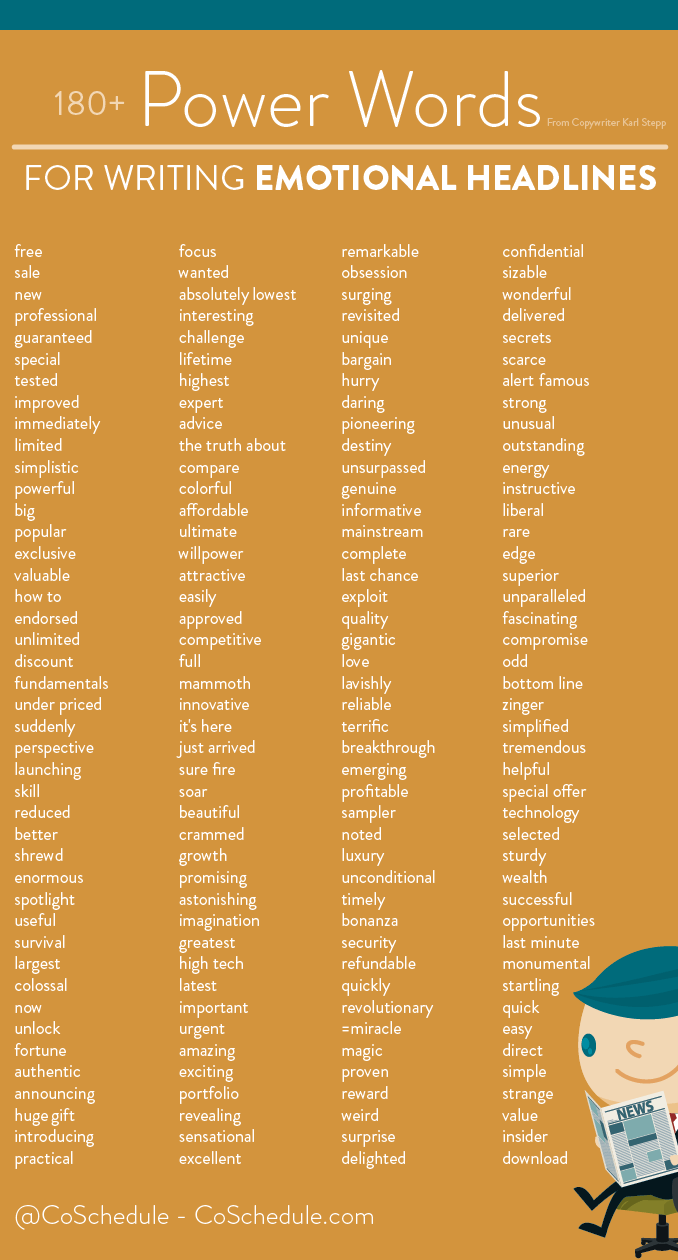You’re up against millions of other blogs when you post, so it’s hard to make an impact. These tips will help you stand out among the crowd. Keep in mind that people skim, so use lists, bullet points, headings and a good font size to make things easy for your readers.

- Readability: Most people read at about a fifth-grade level. Before you hit “publish,” check your readability level. You can use a software program like Grammarly, or just utilize Microsoft Word’s spelling and grammar check. A) If you have a PC go to File > Options > Spelling & Grammar > Click the “Show Readability Statistics” Box. B) If you have a Mac Go to Word > Preferences > Spelling & Grammar > Click the “Show Readability Statistics” Box. Run the Spell Check and you will have your readability.
- Avoid passive voice: Instead of saying “A deal was struck by the author and the publisher,” say “The author and publisher struck a deal.”
- Write in simple past tense: Avoid using “have,” “has,” or “had” unless you’re actually using the verb “to have.” Instead of “She had gone to the pool,” write “She went to the pool.”
- Stick to one tense: Don’t switch from past tense to present (or vice versa).
- Have lots of white space: Check the shape of your post. You should have sentences of varying lengths, lists, images, and plenty of space instead of long blocks of text.
- Avoid modifiers and qualifiers: Examples of these include “a bit,” “some,” “almost,” “a lot of,” “very,” “nearly,” “every,” and “quite.”
- Write from one perspective: pick a point of view and stick to it. If you write from several different viewpoints, you’ll just confuse the reader.
- Write shorter sentences: This goes along with Number 1 and Number 5. Keep it short and simple. Avoid linking words like “as,” “but,” or “then.” Avoid excessive punctuation (commas, semi-colons, colons) and just write shorter sentences.
- Remove the words “the” and “that” whenever possible: Instead of saying “If you feel that you should be using the educated speech and longer sentences, you may assume that you will annoy your readers,” say “If you feel you should use educated speech and longer sentences, you’ll annoy your readers” or even “Using educated speech and longer sentences will annoy your readers.”
- Avoid clichés: Examples include “thinking outside of the box,” “touch base,” or “ignorance is bliss.” These phrases just “get under your reader’s skin.”

Now that you’ve got the basics of blogging down, let’s examine your timing.
As you’ve probably figured out, posting more is going to do you more good than posting less. But how much is enough?
Researchers at HubSpot found that businesses that post 16 times or more a month get nearly 3.5 times more traffic than those that post less than 16. And companies with 10 or fewer employees posting 11 or more times per month received 3 times more traffic than companies of the same size posting only once a month — and they received twice as much traffic as similarly-sized companies posting 2-5 posts per month.
HubSpot also found that companies posting more than 16 posts per month get around 4.5 times more leads than companies posting 4 or less times a month — and the results are compounded over time. The more posts a company publishes over time, the more traffic and leads they get, with a sizable jump once they’ve reached an archive of 400 posts.
Specifically, publishing 400 or more posts over time nets you twice as much traffic and leads as publishing 301-400, and 3 times as much as a company that posts 100 or fewer articles.
Of course, quality trumps quantity, especially in blogging. Don’t just toss out any old post to try to get to that magic number. Look at your data to see how many times a month you can reasonably expect to produce a quality post to publish.
According to data from Kissmetrics, most people read blogs in the morning – with the average time being 11:00am. And the average blog gets the most traffic on Monday morning. When it comes to social shares and going viral, the best day to post is Tuesday.
So how many posts is enough? HubSpot recommends trying for at least 11 a month. That’s 2-3 times per week — maybe Monday/Wednesday/Friday. Once you’ve got a good rhythm going, try for that magic 16-17 posts by posting Monday through Thursday, with the odd Friday thrown in once a month or so.
Keyword research is essential for creating the perfect headline that performs well on search engine results pages. The headline isn’t all that a search engine looks at, of course, but hitting the right keywords will help you get to the top of the list.
Tools like SEMRush and Hubspot’s keyword tool can help you figure out exactly which terms people are searching for, and which might be easier or harder for your blog post to rank with.
You can also create buyer personas with Hubspots free template. This can help you decide what your buyers are looking for.
Here are some more tips to keep in mind:
- The ideal blog post title is 57-58 characters long.
- Headlines between 8-12 words are shared more often on Twitter.
- Headlines between 12-14 words are liked more often on Facebook.
- Headlines ending in a bracketed clarification — 3 Emails That Make Conversions Skyrocket [Templates] — perform 38% better than headlines without.
- Headlines that feature emotional power words are 10 times more likely to be shared.
We’ve talked about how to create a great blog post. However, it’s not enough just to slap some text down on the page.
Finding the perfect image to represent your text is just as important as writing that text.
Here are some places to find free images – and you must either use free images or pay for the rights to an image. Using an image that isn’t yours will net you some hefty fines (hundreds of dollars per image)!
- Unsplash – “The internet’s source of freely usable images.”
- Picography – “Gorgeous, high -esolution, free photos.”
- Magdeleine – “Hand-picked free photos for your inspiration.”
- IM Free – “A curated collection of free web-design resources.”
- Death to Stock – “An artist-owned co-op.”
- Gratisography – “Quirky, creative, always free photos.”
- Stockvault – “Free stock photos.”
- Pixabay – “Stunning free images & royalty free stock.”
- Pexels – “The best free stock photos…”
- Picjumbo – “”Beautiful, free stock photos.”
Where is your favorite place for free images?
One mistake many bloggers make is starting their post without a title or headline.
But wait, you say – that’s the way we were taught to do it in school! Write your essay first, then come up with a catchy title that describes what you’ve just written.
In the world of blogging, however, it’s a little different. Picking something that will “hook” the average web-surfer will help you keep to the topic and craft the perfect post.
Your title should be something that, if you fit it into the subject line of an email, would make the recipient actually open the email and read it. The more specific you can make it, the more likely you’ll get a nibble. Rather than “How to Lose Weight” try “10 Tips to Lose 10 Pounds.”
Use tools like BuzzSumo to find out what’s popular in your niche. This will give you great ideas for your titles (and posts). Also use the sorts of titles that work for others – “How to ___” or “5 Tips to ___” or “Top 10 _____.”
Engage your senses when writing your titles. Vague titles like “How to Fix a Sink” leave readers yawning. Tangible titles like “Stop That Dripping Faucet in 10 Minutes or Less” will have them clicking your link. Write about what the reader will see, hear, or feel.
Another mistake new bloggers make is to give away too much information in their titles. “Save Money By Giving Up Starbucks” tells the reader everything they really need to know without reading your article. “How to Save $200 a Month” will get them to visit your blog.
Cut the fat from your headline. Find the shortest, most hard-hitting way to craft your title and run with it. Find your own style and start making great titles.
Try this next time you blog: create five or ten different titles for the same blog, then pick the one that’s perfect.
Let’s get back to blogging for a bit. The hardest part of the process – for me, at least – is coming up with a good topic.
Here’s how to come up with a boat-load of new topics you can use. The key is to reuse old ideas as well as come up with new ones. After all, many of your readers will be new, so what’s old to you will be unfamiliar to them.
Remember to write down your ideas so you can use them on your blogging calendar!
- Who are your followers? Think about what questions they may have, and what answers they’d like to see in your blog. What topics would interest them? Try to come up with one good topic to begin with.
- Change the scope of your topic. Here’s where you start brainstorming. Let’s say your topic idea was “Blogging.” Changing the scope means shifting from broad to narrow (or vice versa). Additional topic ideas, then, would include “How to Create a Blog,” “How to Write a Blog Post,” “5 Types of Blog Post,” and “How to Brainstorm a Blog Topic.”
- Change the timeframe. Try narrowing the time, or broadening it, to come up with new topics. “The Best Websites of 2019” or “This Month’s Best Writing Blogs.”
- Flip from positive to negative – or vice versa. Instead of writing about “10 Ways to Write a Query Letter,” try writing “10 Things NOT to Include in Your Query Letter.”
- Introduce a new format. Instead of always posting an article, try changing it up with infographics, videos, and checklists. A title like “The Ultimate Guide to Email Marketing” could easily become “The Ultimate Email Marketing Checklist” or “The Ultimate Guide to Email Marketing [Infographic]”.
- Try a topic generator. Hubspot has a great one here.
- Don’t forget to weed out the non-starters. Go through your (now long) list and weed out topics that wouldn’t interest your followers. By this time, you should have much more than a year’s worth of blog topics.
How do you come up with blog topic ideas?
There are three parts to any good blog post.
- Introduction. Explain what you’re going to be writing about and give a brief overview of the post. Establish your credentials and capture their attention in this part of the post.
- Body. The main part of the post. This is where you give your information and present images or links. Remember to break up the text with images or shorter sentences so it’s not one long block of wordage.
- Conclusion. Wrap up the post and reiterate what you’ve told the reader. The conclusion should reflect the primary takeaway you’ve outlined. Your conclusion should also contain your call to action, where you let the readers know what you want them to do, such as click a link or make a comment.
Proofread your post for errors before hitting that “publish” button and add some nice images for flavor.
Here’s some more information on writing a good blog post.
To start with, there are basically five different types of post you can choose from:
- The List Post. This is exactly what it sounds like: making a list of things. This post is a list post.
- The How-To Post. Again, just what it sounds like: directions for performing a specific task. How to Write an Effective Blog Post, How to Write Convincing Dialogue, or How to Show, Not Tell.
- The Curated Collection Post. Gather information pertinent to your blog topic and share it with your readers. Top 10 Websites for Writers, 25 Gifts for Your Writer. Remember to give credit where due when sharing other blogs or images.
- The SlideShare Presentation Post. Images pertinent to your topic. Best Journals on the Market, Gifts for Writers.
- The Newsjacking Post. This means using a popular news story to increase your blog’s popularity. It’s harder to do if you’re writing about writing, as I do, but it’s doable with some creativity.
In the next post, we’ll talk more about the specifics of writing a good blog post. What’s your favorite type of post to write?
“Blog” is actually short for “Web Log.” In the early 1990s blogs began as journals, meant more as an online diary than anything else.
I’m going to do a couple of posts on … blog posting. Here are the basics of creating a good blog.
- Know your audience. Before you even put finger to keyboard, think about who you’re trying to reach. What do they want to know about? What can you write that will resonate with them?
- Make your domain. If you intend to be a serious writer, you’ll probably want to invest a few dollars and get your own domain, either your author byline (www.jeshays.com) or something related to your books. Some inexpensive web-hosting services include GoDaddy, DreamHost, and HostGator. For a blog, I recommend a WordPress site.
- Customize your theme. Did you notice how my website reminds you of the Old West? I happen to have a good friend who’s a graphics designer, but even without help, you can pick and choose from the free templates available. Two things people are going to notice right away are your logo and your “about” page (you can also call this a Bio page), so be sure those are consistent with your brand.
- Pick a topic and title for your first post, then start writing. You might want to make an outline first so you have a good idea where to go. Aim to keep your posts down to around 800 words or so, and break up the text with images so it doesn’t overwhelm your reader. Tag your post with some specific keywords so the reader can browse for topics they’re interested in and end with a call to action letting them know what you want them to do next (subscribe to your email list, buy a book or leave a comment).
In the next post, we’ll dive further into what makes a good blog post. What sorts of posts do you like writing?
If you’re anything like me, sometimes a good blog topic just doesn’t fall into your lap.
Here are some good ideas when you’re having trouble coming up with a good topic:
How-To Posts: writing, like any other craft, always has room for one more “How-To” post. Here are some good ones to play around with (and of course, you’re more than welcome to come up with even more ideas based on what you know):
- How to Invent Compelling Characters
- How to Create a Compelling Backstory
- How to Write Convincing Dialogue
- How to Flesh Out a Flat Character
- How to Breathe Life Into Your Characters
- How to Compose a Good Scene
- How to Compose a Good Chapter
- How to Know When to End a Chapter
- How to Ramp Up the Tension and Conflict in Your Story
- How to Create Atmosphere
Best-Of Posts: Readers love lists, and what better list than one sharing the best of some topic they’re interested in?
- The Best YouTube Videos for Writers
- The Best Twitter Accounts for Writers to Follow
- The Best FaceBook Pages for Writers to Follow
- The Best Instagram Accounts for Writers to Follow
- The Best Books on Writing
- The Best Books on Editing
- The Best Books on Storytelling
- The Best Websites for Writers
- The Best Magazines for Writers
- The Best Places To Write (Outside of Your Office)
Comparison Posts: The idea is to compare any two things, giving the pros and cons of each and showing the strong and weak points in comparison to one another.
- Microsoft Word vs. Scrivener for Writing
- Mac vs PC for Writers
- Pantser vs Outliner
- Writer’s Digest vs The Writer
- FaceBook vs Twitter for Writers
- YouTube Video vs Blog Post for Writers
- Pen and Ink vs Computer for Writing
- Social Media vs Email List for Writers
- Writing Mindset vs Editing Mindset
- Traditional vs Self-Publishing
Question Posts: You can take any sort of position and defend it (or tear it apart if you so wish). Hint – if you start with “Why?” your questions will be more entertaining to most readers, as well as lead more naturally into debate.
- Why do writers make the best lovers?
- Why is editing harder than actual writing?
- Why are most writers busybodies?
- Why is Scrivener the best word processing program for writers?
- Why should every writer have a YouTube channel?
- Why should every writer create a book trailer?
- Why do writers read?
- Why must you “show, not tell”?
- Why must you “kill your darlings”?
- Why is blogging essential to your success?
Lists: Everybody loves a good list, and you can whip up a great blog post by trying the old stand-by — “5 Things …” “Top 10 …” or “3 Reasons to …”
- The Top 10 Reasons to Write
- The Top 10 Websites for Writers
- 5 Books Every Writer Must Read
- The 3 Things Every Writer Must Know
- 20 Fantastic Writing Tools
- 5 Things Every Writer Must Do Before Writing
- 10 Things to Check Before Handing in Your Manuscript
- 5 Songs I Play When Writing
- 5 Sure-fire Ways to Create Winning Dialogue
- 15 Blogs All Writers Must Follow
Personal Essays: As a blogger and a writer, everything you think, feel, or do is fair game for a post. This especially holds true if your essays are about your life as a writer. Just remember to keep these light-hearted or downright funny (unless you’re aiming to incense or turn off your readers).
- How I Dealt With Rejection
- My Most Embarrassing Moment
- What I Have Learned From My Regrets
- My Childhood Home(s)
- How I Landed An Agent
- My Pets and Their Quirky Personalities
- Things My Family Says
- How I Gave Up Caffeine
- The Eulogy I Want Read at My Funeral
- My Goal(s) and How I Plan To Reach Them
Lifestyle Posts: With the right slant, even health and lifestyle posts can appeal to writers.
- How Meditation Can Make You a Better Writer
- Top 10 Snack Choices for Writers
- Can Exercise Make You More Creative?
- 5 Exercises That Can Make You More Productive
- Yoga for Writers: Why Does It Work?
- Eating to Improve Your Brain Function
- Socializing 101 for the Writer
- Top 10 Tips for Focusing
- 5 Super Foods That Will Keep Your Brain Active
- How Much Exercise is Enough For a Writer?
Photo Posts: While perhaps not exactly worth a thousand words, a picture can share a lot with your readers.
- Share photos of your writing space(s)
- Ask your followers to take a photo of your book in their hometown and share the photos and their locations
- Share photos from your travels
- Share photos from your latest book tour or signing
- Share photos of your pets
- Share photos of your readers’ pets
- Share photos of your hometown
- Share photos of your book covers and/or any artwork you have
- Ask your readers to snap a photo of them reading your book and post the photos
- Share photos of your favorite meal(s)
Interviews: This can be a tricky one. You actually have to know someone your readers would like to learn about — or be able to convince a stranger that an interview on your website would be a good idea.
- Interview a famous writer in your genre
- Interview a famous blogger
- Interview a social media expert
- Interview a literary agent
- Interview a publisher
- Interview someone with a special skill
- Interview someone with expertise pertinent to your stories
- Interview a writing teacher
- Interview a typical reader
- Interview a lot of readers or authors and post the average responses
Recap Posts: Any event you attend can be fodder for a good blog post. A recap is a short summary of an event (a webinar, conference, class, or special occasion).
- Recap what you learned at a conference panel
- Recap what you learned at a webinar
- Recap what you learned at a writing class
- Recap what you learned from your mentor
- Recap what you learned from your agent
- Recap what you learned from your publisher
- Recap a special event that inspired you to write
- Recap a venture into a new skill or hobby
- Recap what you learned from a book about writing
- Recap your experiences as a teacher or mentor
5 more ideas to generate blog posts:
- Opinion pieces: Start a debate by posting your opinion and asking for responses
- Free Stuff: post a link to a free short story or novella for loyal readers
- Music: share what you’re listening to, or what songs represent your main characters
- Nonfiction: if you’re a fiction author, write a nonfiction essay about something from your stories, like the history or a site or an event that would have taken place during that time.
- Infographics: these seem to generate more hits, especially on Pinterest
Keep the list going! What is your favorite blog topic or one you’d love to see written?








